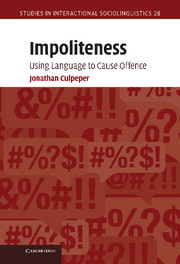Book contents
- Frontmatter
- Contents
- List of figures and tables
- Preface
- Introducing impoliteness
- 1 Understanding impoliteness I: Face and social norms
- 2 Understanding impoliteness II: Intentionality and emotions
- 3 Impoliteness metadiscourse
- 4 Conventionalised formulaic impoliteness and its intensification
- 5 Non-conventionalised impoliteness: Implicational impoliteness
- 6 Impoliteness events: Co-texts and contexts
- 7 Impoliteness events: Functions
- 8 Conclusions
- Notes
- References
- Index
6 - Impoliteness events: Co-texts and contexts
Published online by Cambridge University Press: 16 May 2011
- Frontmatter
- Contents
- List of figures and tables
- Preface
- Introducing impoliteness
- 1 Understanding impoliteness I: Face and social norms
- 2 Understanding impoliteness II: Intentionality and emotions
- 3 Impoliteness metadiscourse
- 4 Conventionalised formulaic impoliteness and its intensification
- 5 Non-conventionalised impoliteness: Implicational impoliteness
- 6 Impoliteness events: Co-texts and contexts
- 7 Impoliteness events: Functions
- 8 Conclusions
- Notes
- References
- Index
Summary
Introduction
From the very first sentence of Section 1.2 where I define the notion of impoliteness used in this book, I stressed its context dependence: impoliteness is a negative evaluative attitude towards behaviours in context. Clearly then, I need to consider in more detail the role of context, and this is the job of this chapter. Here, I will also discuss co-text, a distinct category of context defined by the fact that it is constituted by text. In this chapter and the next I am particularly concerned with impoliteness events, a term I use to refer to constellations of behaviours and co-textual/contextual features that co-occur in time and space, have particular functions and outcomes, and are/can be discussed and remembered by participants after the event. Impoliteness events are the fuel of schematic knowledge about impoliteness. Different participants can of course have different understandings of the same impoliteness event, having activated different schemata – different cognitive contexts – in their understandings (see Section 2.4). Needless to say, a context cannot be everything accompanying the text (including all the knowledge we have), otherwise our minds would be overloaded, so there must be a principle by which context is limited. Here, I follow the view of context articulated in Relevance theory (Sperber and Wilson 1986, 1995), where it is stated that:
The set of premises used in interpreting an utterance … constitutes what is generally known as the context. A context is a psychological construct, a subset of the hearer's assumptions about the world.
(Sperber and Wilson 1986: 15)- Type
- Chapter
- Information
- ImpolitenessUsing Language to Cause Offence, pp. 195 - 219Publisher: Cambridge University PressPrint publication year: 2011



